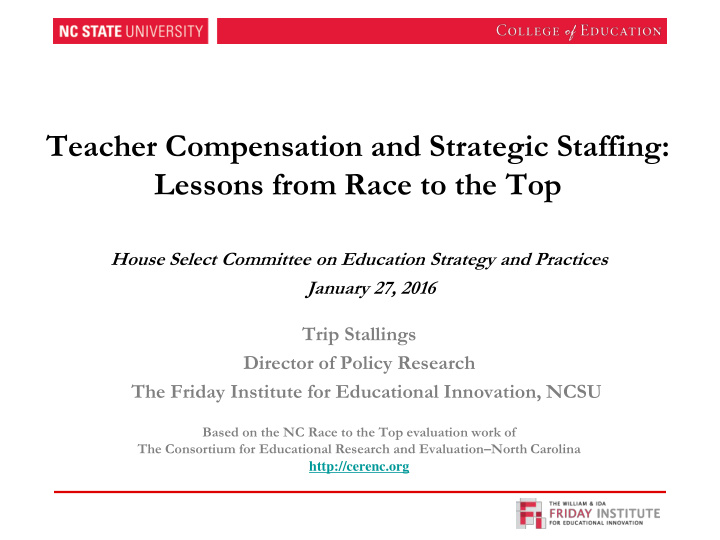



Teacher Compensation and Strategic Staffing: Lessons from Race to the Top House Select Committee on Education Strategy and Practices January 27, 2016 Trip Stallings Director of Policy Research The Friday Institute for Educational Innovation, NCSU Based on the NC Race to the Top evaluation work of The Consortium for Educational Research and Evaluation – North Carolina http://cerenc.org
Overview I. Compensation Options Lessons from Race to the Top: II. Pay-for-Performance (Incentive-Only) III. Strategic Staffing (Differentiated Pay) State Strategic Staffing • Local Strategic Staffing • IV. Summary and Recommendations 2
C I. Compensation 3
C Compensation Three General Areas for Action: • Base Pay • Incentive Pay (including Pay-for-Performance) • Differentiated Pay 4
P4P II. Pay-for-Performance 5
P4P RttT Pay-for-Performance Incentive • Eligibility : Lowest 5% of schools (118 eligible schools) • 2011 and 2012 : $1,500 school-wide incentive for making “high growth” o 2011 : 23 bonus winners o 2012 : 35 bonus winners (but only 8 repeats from 2011) • 2013 and 2014 : $1,500 school-wide, plus additional $500 individual bonus for some teachers (based on individual value-added) http://cerenc.org/wp-content/uploads/2011/10/FINAL-Bonus-Incentive-Program-Report-8-29-13.pdf 6
P4P RttT P4P: Impact • Little evidence of impact on student performance • Most teachers — whether awarded or not — said incentives would not change their teaching behavior or practices: “[Incentives] are not going to change anything about the way I teach. . . . I may make better records if that’s what’s required, [but] it’s not going to really change anything. We don’t teach to get extra money. It’s not why we do it.” • More teachers support school-wide (75%) rather than classroom-level bonuses (25%) • Most are looking for across-the-board salary increases ahead of performance-based incentives: “[Current teacher pay] is disrespectful. . . . [V]alue is not given to what we do .” http://cerenc.org/wp-content/uploads/2011/10/FINAL-Bonus-Incentive-Program-Report-8-29-13.pdf 7
P4P Other Recent Pay-for-Performance Studies In other states: • Little consistent evidence that traditional P4P-only incentives increase student outcomes • Whether incentives are individual or team does not appear to make a difference • Little consistent evidence that teacher behavior changes because of presence of P4P-only incentives • Incentive amount does not appear to matter : Several programs studied offered large incentives 8
SS III. Strategic Staffing 9
SS The Strategic Staffing Landscape Element Approaches to Operationalization School identification based on: Measures of student socioeconomic characteristics Size of special needs population Focus on High- Teacher turnover rates Need Schools NC ABCs Performance Composites and other measures of student achievement and/or growth Judicial mandate Differentiation based on: Focus on Differ- Student performance and/or growth (via value-added modeling or some other method) entiation of Formal and informal educator evaluations Educator Voluntary participation in optional school programs Effectiveness Other qual. measures (e.g., evidence of leadership, results of mandatory re-application for positions, etc.) Individual incentives based on: Other incentives: Actions Grade- and school-wide incentives based on o Development of exemplary teaching grade-level or school-wide student performance materials and/or growth (including incentives for non- Incentives in o Willingness to move to a within-LEA certified staff) Support of target school Incentives in support of targeted professional High-Need Willingness to take on leadership development and additional coursework o School and roles Recruitment incentives Teacher Differ- Willingness to take on challenging Retention incentives o entiation Foci teaching assignments Non-financial incentives (e.g., housing, equipment, Performance etc.) Student performance and/or growth o o Educator evaluation results 10
SSS State Strategic Staffing Efforts (RttT) • Incentive : Annual $5,360 voucher for tuition, housing, loan repayments for qualified teachers who moved to identified schools • Eligibility : 10 districts and 30 schools with low graduation rates and low performance history • Scope : Anticipated 181 participating teachers; however, only six teachers qualified in 2011-12, and six more in 2012-13 o By Spring 2013, two teachers had left their schools o No teacher reported transferring due to the incentive http://cerenc.org/wp-content/uploads/2011/10/FINAL-State-Strategic-Staffing-8-29-13.pdf 11
LSS Recent Local Strategic Staffing Plans in NC Over $76M invested between 2010 and 2014 12
LSS Example of a Strategic Staffing Plan (Wayne Co.) • The Plan: o Individual- and school-level incentives for retention, prof. devel., and/or classroom- and school-level student performance • Focus on High-Need Schools/Populations: o Available at one hard-to-staff, underperforming middle school • Differentiation of Teacher Effectiveness: o Individual incentives for teachers who demonstrated exceptional student growth (via EVAAS estimates and/or teacher eval. data) • Incentives: o 7 days additional pay for 40+ hours of professional development o Recruitment/retention pay for new/returning teachers o Mix of school-wide and individual-level performance incentives o Total incentive pay up to $4,500 (teachers), $2,750 (classified staff) 13
S&R IV. Summary and Recommendations 14
S&R Summary • The Past Should Guide the Future : The state has experimented with many alternative pay plans over the years • P4P Alone Is Not Enough : There is no consistent evidence that performance incentives alone o have a meaningful, sustained impact on recruitment, retention, or student performance Teachers report that they are not motivated by performance o incentives in isolation • Districts Can Lead the Way on Strategic Staffing : Many districts have designed and administered local-context strategic staffing plans — but few have been rigorously evaluated 15
S&R Recommendations • Continue to fund across-the-board salary increases to approach regional parity & stem salary-based attrition • Fund multiple strategic staffing differentiated pay pilots that build on past state and local efforts • Pilot scope : At least 3 years in 6 to 8 representative districts (urban/rural; low- weath/higher-wealth; Mountain/Piedmont/Coastal) • Require fully-realized strategic staffing differentiated pay plans, not incentive- only plans; prioritize existing plans with defensible track records • Support robust evaluations of the pilots • Prioritize within-district staffing outcomes (redistribution, retention, school climate) over recruitment or student achievement outcomes • Commit to scaling up statewide the best of these options after the third year • Allow districts to choose among “winning” options • Plan for sustainability 16
Recommend
More recommend